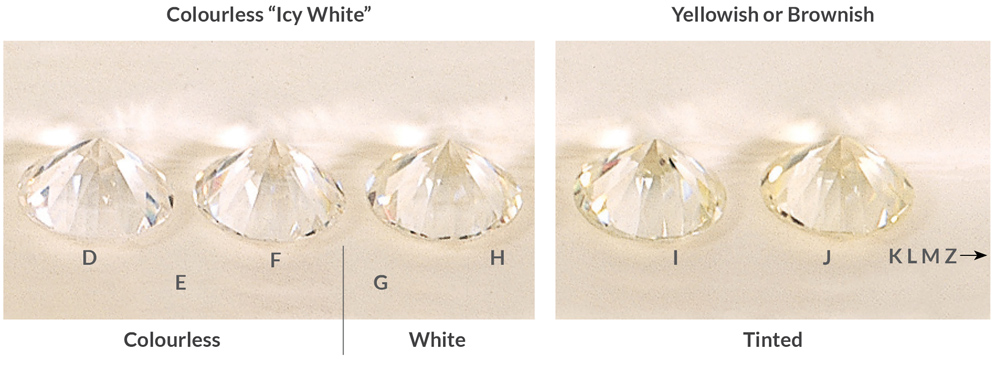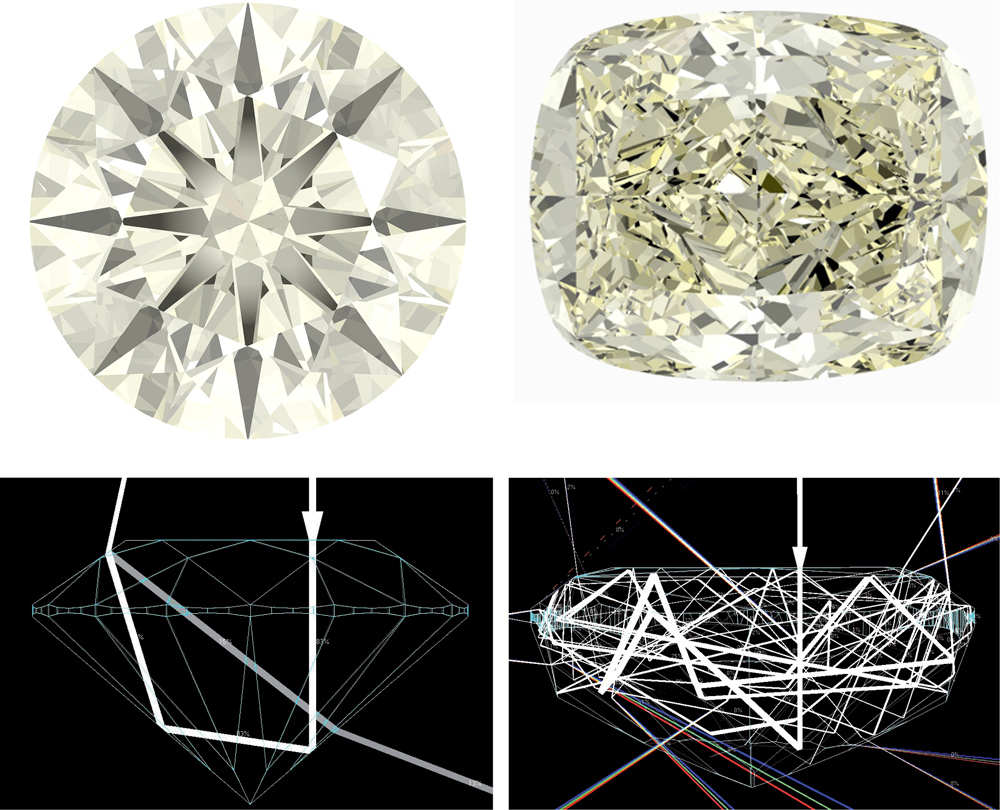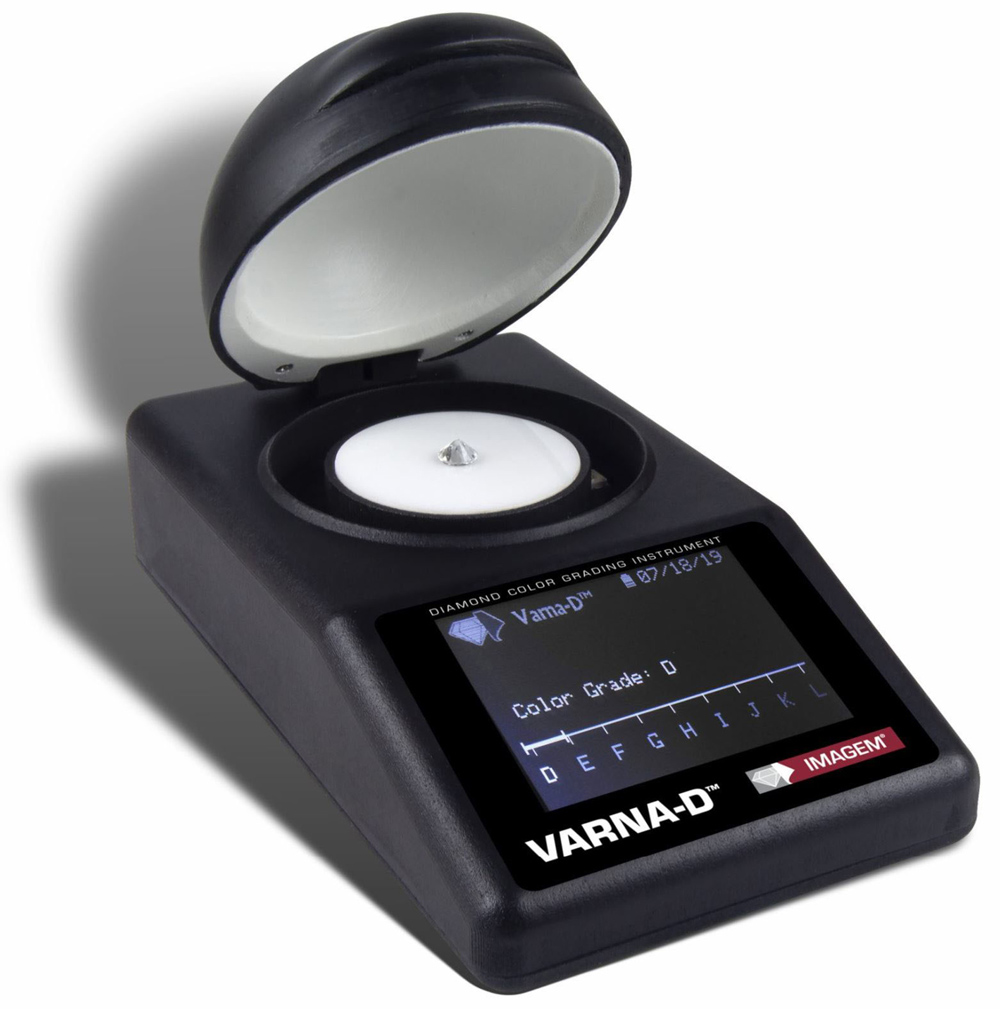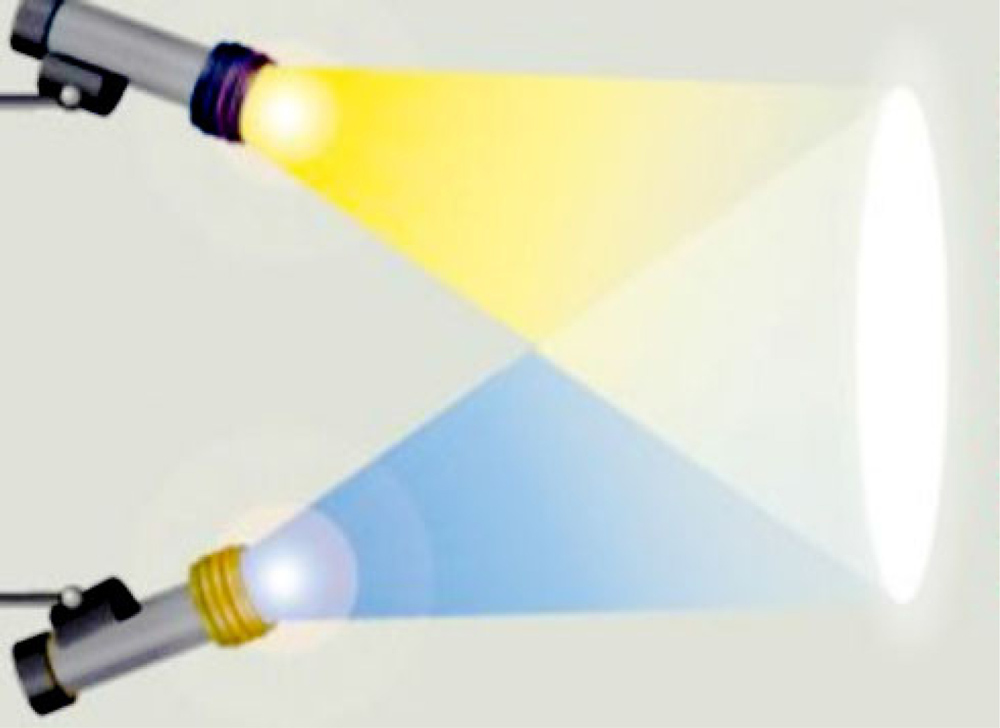Learn: Diamonds > Colour
Introduction
Fluoresence
Colours of Diamonds Explained
Cut Quality
What Colour Should I Buy?
How Diamonds Are Graded
Grading Colour With Instruments
Colour Myths & Facts
1. Looking in some shops and I could not see the difference between colours D and F:
We can’t either when the diamond is set unless we’re in the lab and the diamond is perfectly clean
2. I want to put a 1ct D into a setting with G little diamonds in the band:
That is fine because the smaller the diamond, the less the colour you can see face-up

colours of diamonds explained
Most people associate quality diamonds as being colourless or white.
Rarely do diamonds come in other colours which we cover in – Fancy Coloured Diamonds. Pure colourless diamonds are graded as colour D and cost the most. Cost drops as diamonds become more yellowish (or brownish) on the colour grade scale. More saturated yellow and brown diamonds are graded as fancy coloured diamonds.
D coloured diamonds are rarer than say F, but it is almost impossible for most people to tell a D from an F when the diamonds are set in a ring.
If you’re choosing an engagement ring it’s safer to choose a relatively colourless diamond. A diamond that is slightly yellowish or brownish may send a cheapskate message unless you know that the recipient actually prefers ‘warmer’ coloured diamonds.
‘Warmer’ colour fans often have an affinity for old antique styles of diamond cuts in colour grade like J, K, L, and M. Most of the diamonds discovered in South Africa in the 1800’s, were yellowish. So old cut aficionados associate old cuts with lower diamond colours.
How do you choose the best coloured diamond?

At Holloway Diamonds, the minimum colour grade is set at H. We believe when customers want a colourless diamond it should be colourless. Garry Holloway took the above photos decades ago and left out the E and G stones because the grades are so close to one another as to make the separation of tints difficult to note.

These ray-trace yellowish diamond images are digitally the same colour. This shows how ideal cut round diamonds ‘face up’ whiter. In the cushion cut, light bounces around with long ray paths. This ‘crushed ice’ style of cut is best suited to increasing the intensity of fancy coloured diamonds.
Let’s start with Cut Quality
A consideration to make is the diamond’s cut. If you take a quick look at the picture of the grading process (left), you’ll notice that colour is graded through the back of the diamonds – why the back, though?
The back of the diamond exaggerates a diamonds body colour and that always made it easier than grading the colour by looking at the front because.
On top of that, fancy shaped diamonds almost always show more colour than well-cut round brilliant cuts. This is especially so in diamonds that have what we call ‘crushed ice’ or the appearance of lots of tiny facets. So this is yet another of the historical errors that have been perpetuated because GIA established the colour grading system the wrong way. Consumers want to know how a diamond will appear face up because no one can see the colour face down once the diamond is set.
On account of the size phenomenon, we prefer to stock diamonds from H to D, but for diamonds over 2.00ct, we stock only G and above. In fancy shaped diamonds we buy F in larger sizes. The only exception to these rules is if the diamond is blue fluorescent, and that’s a story all by itself. We also don’t set perfectly cut round diamonds next to fancy coloured diamonds, because they are cut to enhance colour and that means their light return is compromised in order to enhance the colour and get rid of dark zones.
At Holloway Diamonds the minimum colour grade is set at H because we believe when our clients want a colourless diamond it should be colourless.
WHAT COLOUR SHOULD I BUY?
It depends of course on you, your budget, family or peer pressure etc. D is rare and rarity attracts highbrow buyers who may pay more than most people can afford. The truth is, to tell the difference between a 1 ct D and F colour, you need to be in a lab with white or grey walls and have the diamond face down in a white background. F can be half the price of D so you can take advantage of saving or afford a larger diamond.
Everything about diamonds is a trade-off. An impressive-looking diamond must first have a great cut and be crystal clear, it should look white and people should not be able to see any inclusions.
An ideal example of the sweet spot between these two factors could be an F to G VS2 to SI1 and that diamond will cost about 1/3rd of a D flawless diamond. If wisely chosen, will look exactly the same or better because very few D flawless diamonds are cut to our standards!

GIA Diamond Dock™ was developed for a diamond cut quality study and today is used for color grading diamonds. Inset is the pivoted tray to enable rocking the stones for better comparison.
How diamonds are graded
The traditional grading system involves comparing the diamond with a master set. You compare the diamond with 2 or 3 different master stones and then place the diamond you are assessing on either side of the closest master stone. The final grade is set against a master stone diamond on the upper end of a colour grade boundary. This is a traditional method, but things have changed and most colour grading is done by instruments these days.
Grading Colour with Instruments
In 1997, GIA made the decision to use its laboratory and research resources to develop a colour measurement device to match the visual D-to-Z colour grading methodology as closely as possible. Pity that they did not include a face-up colour! From 1999 for a year they cross-correlated visual and instrumental grading and managed good correlation.


fLUORESCENCE
Fluorescence is quite important. We will summarize fluorescence here, but we have an entire page dedicated to fluorescence. Since up to a third of all-natural diamonds fluoresce blue when exposed to UltraViolet (UV), and blue is the complementary colour to yellow, some bleaching occurs in any environment with some visible violet and near-visible UV light. Some diamonds fluoresce in other colours, but that’s rare and more common among fancy coloured diamonds. In a lot of environments, there is enough UV to improve a diamond’s colour appearance. When there is very little UV, generally there is not enough light to effectively see the colour of a diamond, especially when it is set.
In September 2021 GIA published a scientific article explaining that fluorescence makes diamonds brighter and improves their colour in daylight. The fear of hazy or milky dulling only ever occurs with certain types of light scattering inclusions. Something our founder, Garry Holloway discovered years ago and we have written about in blogs.
Fluorescent diamonds currently sell for less than non-fluorescent diamonds, but before 1993 they sold for a premium. The change resulted from a single event, a TV exposé in Korea.
Read the blog
